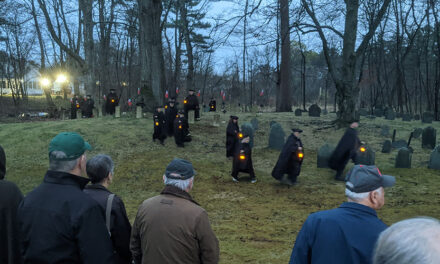Published December 5, 2018
By DAN TOMASELLO
LYNNFIELD — Expressing no confidence in the commissioners of the Lynnfield Center Water District (LCWD), the Board of Selectmen authorized Town Counsel Tom Mullen to craft proposed legislation that would amend the district’s enabling act during Monday’s meeting.
The selectmen discussed the LCWD one week before ratepayers head to the Lynnfield Middle School cafeteria to vote at a special district meeting, beginning at 7 p.m. on Monday, Dec. 10. The LCWD Board of Commissioners scheduled the special district meeting in order to seek approval for the $5.25 million greensand filter treatment plant project for the Glen Drive well field and a $250,000 supplemental water supply study. The warrant for the special district meeting will also include three citizens’ petitions (see separate story).
“Members of the commission were invited to attend tonight’s meeting and they declined,” said Selectmen Chairman Dick Dalton.
Wymon Way resident Rob Almy, who was the manager of the Santa Barbara County Water Agency from 1990-2008, said he submitted two citizens’ petitions for the special district meeting. He started attending LCWD board meetings after residents began raising concerns about discolored water.
“I have had a number of concerns that I have expressed to the district including access to their public documents, the way their board meetings have been run and making information available in a timely manner,” said Almy. “I have shared those concerns with their chair (Connie Lecesse) and their legal counsel.”
Almy gave an overview of the two warrant articles he submitted for the meeting. He said Article 3 seeks to allocate $250,000 for the purpose of undertaking a supplemental water supply study. Article 4 would appropriate $200,000, which would be used for a feasibility study on iron and manganese treatment. The LCWD has attributed iron and manganese to discolored water issues that have impacted residents living in the Apple Hill Lane, Chestnut Street, Cortland Lane and Lowell Street areas of town.
“It’s been problematic for a number of their customers,” said Almy. “I am not personally affected and I know many customers are not, but we understand and support the notion of addressing that problem and dealing with it. However, after several months of going to their meetings and asking for additional information, I am personally not satisfied that they have provided the public with sufficient information to support committing $5.25 million now. I think there needs to be some additional work to provide the public with the appropriate information for that design process. At this point, we haven’t seen a feasibility study or preliminary engineering.”
Almy noted Article 5, which was submitted by Russet Lane resident Stephanie Rauseo, also seeks to allocate $250,000 for a supplemental water supply study. He is recommending that ratepayers approve the iron and manganese study and one of the water supply studies. He opposes Article 2, which was submitted by the water commissioners.
Dalton said he was told that the water commissioners did not take formal votes on closing the warrant or setting the rates and posted the incorrect agenda for the Nov. 26 meeting. He inquired if those accusations are true.
While Almy said he could not comment on the warrant and rate claims, he said the water commissioners’ agenda was different than the one that been had posted.
“It’s unfortunate,” said Almy.
“Is that a clear violation of the Open Meeting Law?” Dalton asked.
“I am not a lawyer,” said Almy. “But from what I understand, they have to post the agenda 48 hours before. I saw the agenda on (Nov. 23) and it was different when I saw it on (Nov. 26). Did the district do anything to get the word out that there would be changes to the agenda? I don’t know.”
Dalton said having the LCWD tie into the MWRA would address both discolored water issues and would prevent watering bans during the summer.
“It seems to me that we are focusing on a Band-Aid short-term solution to things and not really considering what is going to happen down the road,” said Dalton.
Almy said the $250,000 water supply study could serve as a first step to joining the MWRA, which he noted is an extensive and expensive process.
Selectman Phil Crawford said, “It seems very premature to spend $5.25 million on a filter system.” He said the LCWD should make cost estimates for joining the MWRA available to the public.
“It would make a lot more sense to know what those parameters are before we spend a sizable amount of money on a filter just to fix one well,” said Crawford.
Sagamore Road resident John Scenna, who works as Melrose’s DPW director, said he has had discolored water in his home.
“We have heard over and over again that the water is safe to drink,” said Scenna. “Nobody would buy that water if you put it up against anything in the supermarket.”
Last summer, Scenna proposed to the water commissioners that they install specialized filters in the homes that have had discolored water.
“I have yet to see that proposal come forward,” said Scenna. “If there are 100 homes affected and it costs $2,500 a home, its $250,000 compared to $5.25 million.”
In response to a question from Dalton, Scenna said “purchasing water from the Lynnfield Water District as opposed to directly from the MWRA is the best long-term solution.” The LWD purchases water from the MWRA.
“Going right to the source will cost you more,” said Scenna. “The MWRA has benefits, but with those benefits comes with a little more cost.”
Scenna noted there are some communities that have a hybrid system. As an example, he said Wakefield supplements its MWRA water with water from Crystal Lake.
Moving forward, Scenna urged the selectmen and Town Administrator Rob Dolan to continue raising awareness about the issue.
“Let’s keep searching for options to solve the problem,” said Scenna. “The warrant articles the residents have proposed do that. At the end of the day, we want to solve a problem and solve it correctly. We want to solve the quality issue and the quantity issue.”
Patrice Lane resident Pat Campbell expressed her displeasure with the LCWD discussion.
“I would like to urge that this board and the water district cooperate,” said Campbell. “It’s not a contest. I don’t like the tenor of what is going on.”
Campbell said CDM Smith engineers have been attending LCWD board meetings and have been giving presentations about the project. She said the water commissioners’ meetings have been “sparsely attended.” She also opposes joining the MWRA.
“The MWRA is not necessarily the right conclusion,” said Campbell. “It’s an above ground water source. It’s more subject to pollution and terrorism. Greensand filters are already in use at the Phillips Road well field. I hope a lot of people will show up on Dec. 10.”
Selectmen call for changes
Dalton said he and Dolan have met with LCWD officials privately earlier this year, where they made suggestions to the district.
“Most of our suggestions were ignored,” said Dalton. “They have basically cut off conversations with us because they don’t like what they hear from us in private.”
Dalton said he was “terribly disappointed” that the LCWD’s superintendent search committee will include all three water commissioners. The search committee, which will also include Almy and Campbell, will be tasked with finding a successor to LCWD Superintendent Ken Burnham. Burnham, who is also a water commissioner, is retiring on Jan. 2.
“It’s a farce,” said Dalton. “When we recruited the incoming fire chief months ago, I sat on the search committee and the other six members were not selectmen. When we went through the town administrator’s search, Chris Barrett was the selectmen representative on the search committee and the rest of the members were residents. This whole search committee sham has me disturbed.”
Dalton noted LCWD officials have said, “In private meetings that (Burnham’s) successor has already been chosen.” He informed the Villager on Tuesday that LCWD Assistant Superintendent Nick Couris is being eyed as Burnham’s replacement.
“Is that successor qualified? Who knows?” said Dalton during the meeting. “If that screening committee goes about its business, whatever Mr. Almy and Mrs. Campbell say will be disregarded. The three commissioners, in my opinion, have made up their mind and have expressed that to me and the town administrator.”
Dalton proposed having State Rep. Brad Jones and State Sen. Brendan Crighton file legislation that would amend the LCWD’s enabling act.
“I think we will do a disservice to the community if we sit here and not take some action,” said Dalton.
Crawford agreed.
“If you have a three-member board like we have here, you cannot have more than one member on a search committee,” said Crawford. “That is a violation of the Open Meeting Law. There should only be one commissioner on that search committee. I am glad they picked two residents, but having the three commissioners there makes it useless for anyone else to be there. It doesn’t make any sense.”
Barrett said residents have been troubled the selectmen have no authority over the LCWD. He said it’s “beyond repulsive” that residents have had to deal with discolored water in their homes. He was also infuriated that the water commissioners did not attend the meeting even though they were invited.
“I think we should consider the legislation,” said Barrett.
After the discussion, the selectmen authorized Town Counsel Tom Mullen to craft proposed legislation that would amend the enabling act that controls the LCWD. Mullen will be presenting the proposals to the selectmen at their next meeting.
In the meantime, Crawford urged ratepayers to attend the special district meeting on Monday.




